ISO 27001 Audit & Process: How to conduct

An ISO 27001 audit is more than a compliance checkbox—it’s a comprehensive evaluation of your organization’s ability to safeguard sensitive information through an effective Information Security Management System (ISMS). Whether it’s an internal assessment, a certification audit, or a third-party review, these audits ensure your ISMS aligns with ISO 27001 standards and evolves to address emerging risks.
This blog explores the various types of ISO 27001 audits, their importance, and the step-by-step process for achieving compliance, along with how tools like Scrut Automation can simplify and accelerate your journey.
What is an ISO 27001 audit?
An ISO 27001 audit is a structured process to assess the effectiveness of your organization’s ISMS in protecting information assets. An ISMS is a systematic approach to managing sensitive information, ensuring its confidentiality, integrity, and availability by addressing people, processes, and technology. The audit evaluates whether your ISMS aligns with the ISO/IEC 27001 standard’s guidelines and ensures it’s not just well-documented but also effectively implemented and continuously improved.
This ISO 27001 compliance audit covers critical areas such as risk assessment, access control, incident management, and supplier security, ensuring a robust approach to managing information security risks.
ISO 27001 certification is relevant across industries, especially for businesses that handle sensitive or regulated data, such as those in finance, healthcare, IT services, and cloud computing. While certification is not universally mandatory, some industries or contracts require it—especially when working with enterprise clients or government tenders.
Accredited bodies like the British Standards Institution (BSI), TÜV Rheinland, and DNV conduct the audits and issue certifications. While not legally mandated everywhere, ISO 27001 certification often becomes essential for organizations aiming to meet regulatory requirements, build trust, and stay competitive in their markets.
What are the different types of ISO 27001 compliance audits?

ISO 27001 compliance audits are essential for evaluating and maintaining an effective ISMS. These audits are broadly categorized into internal, external, and supplier/third-party audits, each with distinct objectives and processes.
ISO 27001 internal audit
An ISO 27001 internal audit is an organization’s self-assessment process to ensure that its ISMS aligns with the ISO 27001 requirements. Conducted by an internal auditor or an independent third party hired by the organization, this audit evaluates the effectiveness of implemented controls, identifies gaps, and ensures the system’s readiness for external audits.
The frequency of internal audits is typically annual but may vary based on the organization’s size and complexity. Internal audits are mandatory for achieving and maintaining ISO 27001 compliance and are also known as first-party audits.
The process involves several key steps, including a documentation review to assess policies and procedures, evidential audits to verify that processes are followed, in-depth analysis of findings, preparation of an audit report, and a management review to ensure top-level oversight and corrective actions. Internal audits serve as a preparatory measure, helping organizations address issues before an external audit.
ISO 27001 external audit
An ISO 27001 external audit is conducted by an accredited third-party certification body to validate that the organization’s ISMS complies with the ISO 27001 standard. External auditors are qualified professionals certified to assess the implementation and effectiveness of ISMS controls.
External audits are conducted periodically, including an initial certification audit and periodic surveillance audits during the three-year certification cycle, followed by a recertification audit. They are mandatory for obtaining and maintaining ISO 27001 certification and are also referred to as third-party audits.
These audits involve examining ISMS documentation, interviewing key stakeholders, observing processes, and evaluating the overall security posture. External audits ensure the organization meets all ISO 27001 requirements and is prepared to address evolving risks effectively.
ISO 27001 supplier or third-party audits
Supplier or third-party audits are conducted to assess the compliance of external vendors or partners with ISO 27001 standards. These audits are critical when organizations rely on third-party services or products that interact with sensitive data or are part of the supply chain. Conducted either by the organization itself or a hired external auditor, these audits ensure that suppliers maintain adequate security measures and align with ISO 27001 requirements.
Supplier audits typically include a review of the vendor’s ISMS documentation, an assessment of implemented controls, and verification of compliance through evidence and interviews. While not always mandatory, they are often conducted as part of vendor risk management processes or contractual obligations. Supplier audits may also be referred to as second-party audits, as they involve evaluating external entities connected to the organization.
How many stages are there in the ISO 27001 external audit?
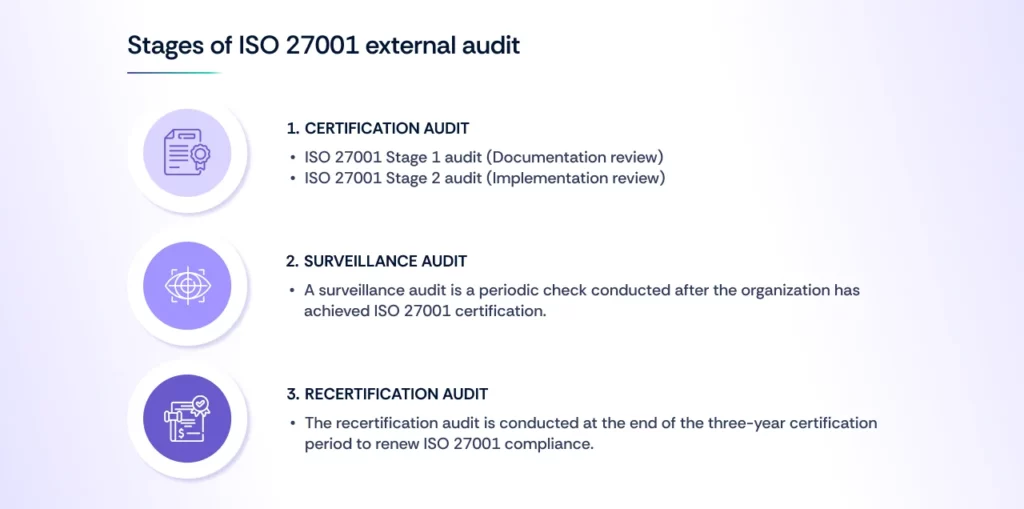
The ISO 27001 compliance audit process consists of multiple stages, each focusing on different aspects of the ISMS lifecycle. These audits are designed to assess whether your organization meets the ISO 27001 standard’s requirements, ensuring both initial compliance and ongoing maintenance of certification.
1. Certification Audit
The ISO 27001 certification audit, also known as the external audit, consists of two main stages, both critical to achieving certification and ensuring compliance with the ISO 27001 standard.
ISO 27001 Stage 1 audit (Documentation review)
The Stage 1 audit, also known as the documentation review, is the initial step in the ISO 27001 compliance process. In this phase, the auditor evaluates the organization’s ISMS documentation to ensure it aligns with the ISO 27001 standard. This includes reviewing policies, procedures, risk assessments, and other foundational elements.
The goal is to identify any gaps or inconsistencies that need to be addressed before proceeding to the next stage. A successful Stage 1 audit demonstrates that the ISMS is well-prepared for implementation and certification.
ISO 27001 Stage 2 audit (Implementation review)
The Stage 2 audit, often referred to as the certification audit, is a comprehensive evaluation of the ISMS in practice. During this stage, auditors assess the real-world implementation of controls, verify compliance with ISO 27001 requirements, and evaluate the effectiveness of the ISMS in managing and mitigating risks.
Evidence is gathered through document reviews, interviews, and process observations. Successfully completing the Stage 2 audit leads to ISO 27001 certification, demonstrating the organization’s adherence to information security best practices.
2. Surveillance Audit
A surveillance audit is a periodic check conducted after the organization has achieved ISO 27001 certification. Its purpose is to ensure that the ISMS remains compliant and continues to function effectively. Surveillance audits are typically performed annually during the three-year certification cycle. At least two surveillance audits are required during this period, depending on the schedule set by the certification body.
This audit, also known as a maintenance audit or surveillance assessment, focuses on verifying that the ISMS is not just operational but also continuously improved to address evolving risks.
3. Recertification audit
The recertification audit is conducted at the end of the three-year certification period to renew ISO 27001 compliance. During this audit, the ISMS undergoes a comprehensive reassessment to confirm that it continues to meet the standard’s requirements. The recertification audit, sometimes called a renewal audit or reassessment audit, evaluates any improvements or changes made to the ISMS over the certification cycle.
Successfully completing this audit extends the validity of the ISO 27001 certification for another three years, provided the organization continues to meet all compliance requirements.
Who performs ISO 27001 audit?
ISO 27001 audits are performed by accredited certification bodies, such as the British Standards Institution (BSI), TÜV Rheinland, and DNV. These organizations have qualified auditors who assess whether your ISMS complies with the ISO 27001 standard. Only audits conducted by these accredited bodies can result in official certification.
Why is the ISO 27001 audit important?
The ISO 27001 audit is essential for ensuring an organization’s ISMS is compliant, secure, and resilient against threats. It identifies vulnerabilities, enhances risk management, and demonstrates a commitment to protecting sensitive information. By building trust with stakeholders and streamlining processes, it supports regulatory compliance and operational efficiency. For businesses in regulated industries or targeting enterprise clients, it’s a strategic tool for achieving long-term security and competitive advantage.
What are some ISO 27001 audit requirements?
ISO 27001 audits require organizations to provide mandatory documents and evidence to demonstrate compliance across all clauses of the standard, ensuring the ISMS is effectively implemented and maintained.
The following clauses of ISO 27001 show the requirements of the audit.
Clause 4: Context of the organization- Organizations must define internal and external factors, stakeholder needs, and the ISMS scope through documented analysis.
Clause 5: Leadership- Top management must establish an information security policy, assign roles, and ensure resources and alignment with organizational goals.
Clause 6: Planning- Organizations need to identify risks, set security objectives, and create a risk treatment plan with documented evidence.
Clause 7: Support- Evidence of allocated resources, training, awareness programs, and communication plans must be provided.
Clause 8: Operation- The organization must document and implement operational controls to achieve ISMS objectives and mitigate risks.
Clause 9: Performance evaluation– Performance evaluation requires evidence from internal audits, monitoring processes, and management reviews.
Clause 10: Improvement- Non-conformities must be addressed with corrective actions, and continual improvements must be documented.
How to perform the ISO 27001 audit process?
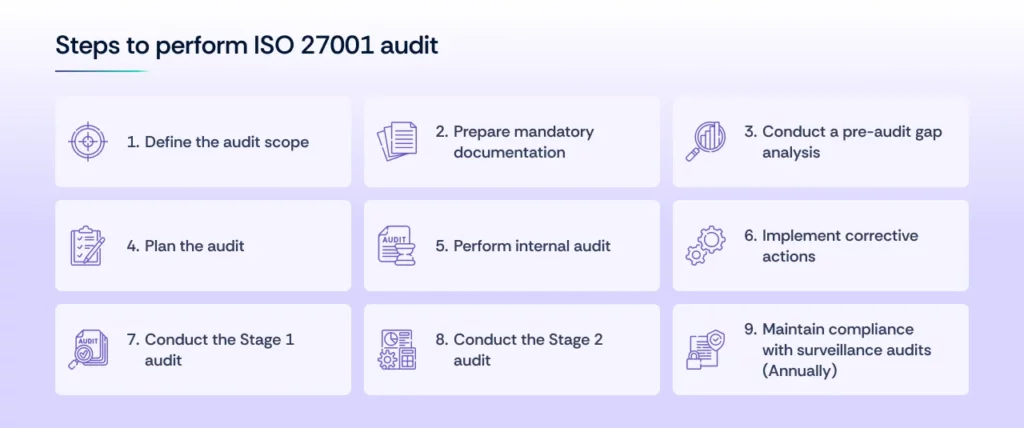
The ISO 27001 audit process involves a series of well-defined steps to ensure compliance, identify gaps, and verify that the ISMS is effectively implemented.
Below is a step-by-step guide to carrying out the audit process, along with approximate timelines for each phase.
- Define the audit scope
- Prepare mandatory documentation
- Conduct a pre-audit gap analysis
- Plan the audit
- Perform internal audit
- Implement corrective actions
- Conduct the Stage 1 audit
- Conduct the Stage 2 audit
- Maintain compliance with surveillance audits (Annually)
After certification, conduct periodic surveillance audits to ensure ongoing compliance.
Has the audit process changed after the ISO 27001:2022 update?
Yes, the audit process has been updated to align with the ISO 27001:2022 changes. Key updates include:
- Updated controls in Annex A: Controls reduced from 114 to 93 and grouped into 4 categories (Organizational, People, Physical, Technological). New controls like threat intelligence and cloud security were added.
- Risk-based approach: Greater focus on how organizations identify and mitigate risks, tailored to their specific context.
- Continuous improvement: Auditors now evaluate monitoring, reviews, and improvements in ISMS practices.
- Focus on modern technology: Enhanced scrutiny of controls addressing cloud security, remote work, and emerging tech risks.
Preparation tip: Update ISMS documentation, conduct a gap analysis, and ensure internal teams are trained on the new requirements.
How Scrut can automate and speed up the ISO 27001 audit process
Scrut simplifies and accelerates your ISO 27001 audit journey by leveraging automation and real-time insights. Here’s how it transforms the process:
1. Centralized control management
Scrut consolidates all your policies, controls, and evidence into a single platform, eliminating the need for manual tracking across multiple tools. This unified view ensures you stay organized and audit-ready.
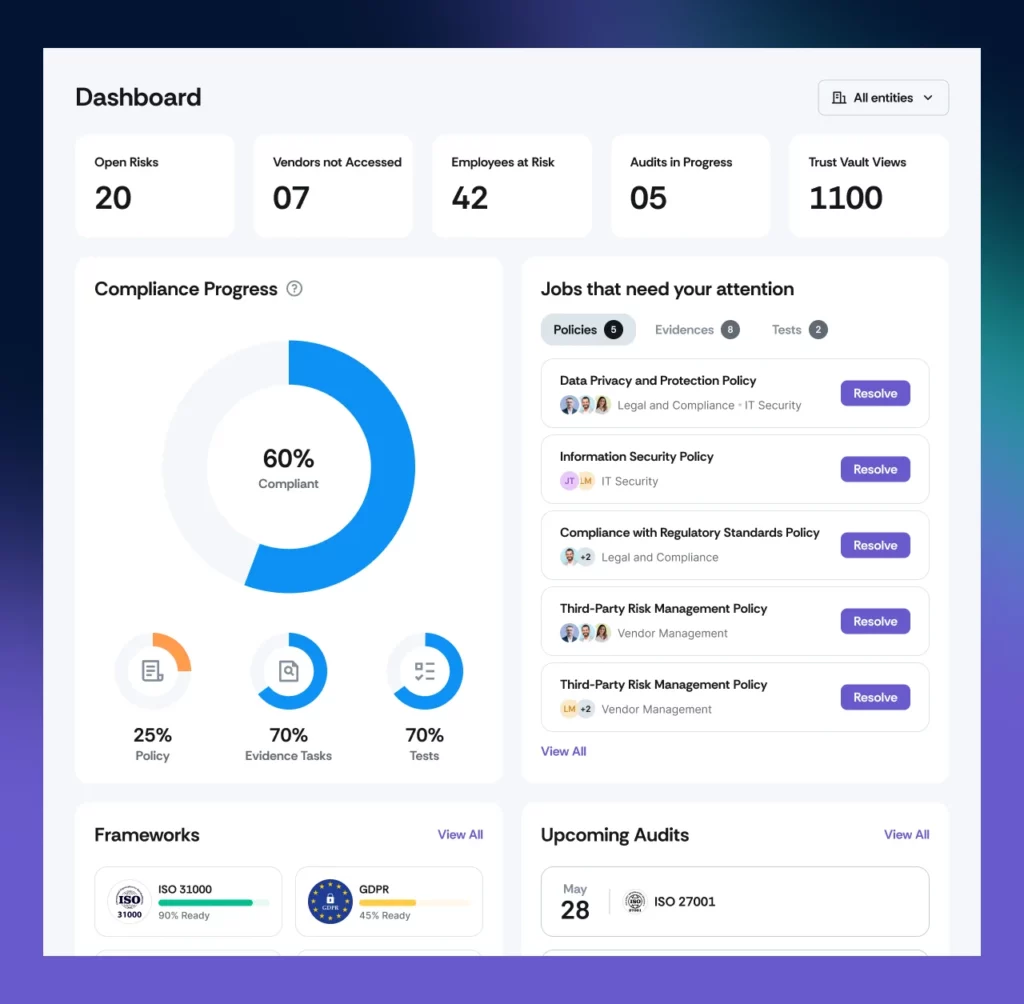
2. Automated evidence collection
With integrations across your tech stack (cloud providers, productivity tools, identity management systems, etc.), Scrut automates evidence collection, saving hours of manual effort. Real-time updates reduce the risk of outdated evidence derailing your audit.
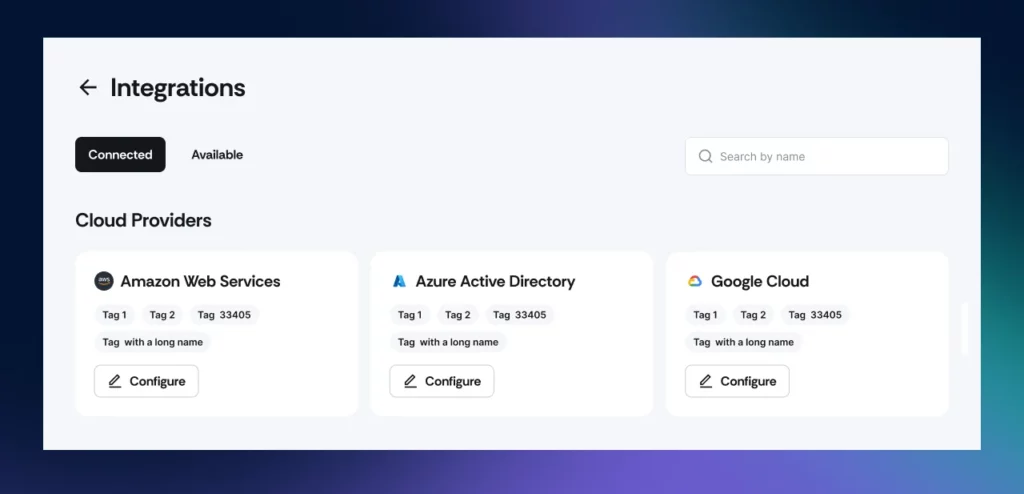
3. Continuous compliance monitoring
Scrut provides real-time monitoring of your compliance posture. Automated alerts flag gaps, enabling you to address issues proactively before the audit begins.
4. Audit-ready documentation
Scrut helps you maintain audit-ready documentation, ensuring your ISMS policies, procedures, and records are always up-to-date. This reduces back-and-forth with auditors and accelerates their review process.
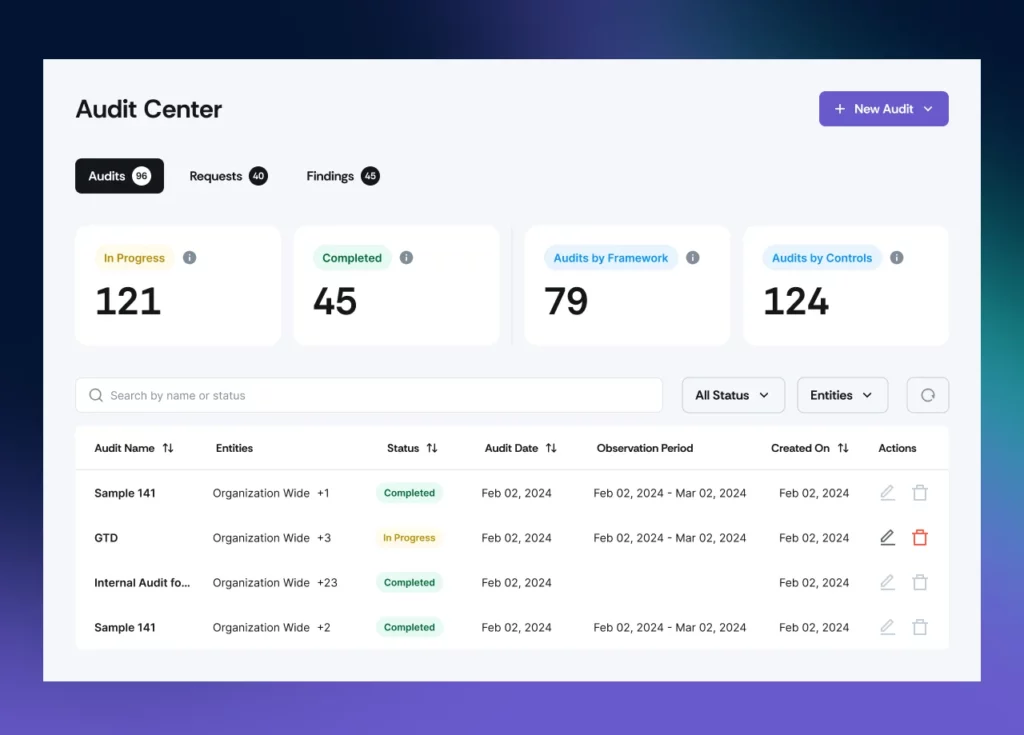
5. Simplified risk management
Scrut streamlines risk assessment and treatment workflows, helping you identify, assess, and mitigate risks efficiently. This aligns your risk management practices with ISO 27001 requirements and impresses auditors.
6. Pre-built templates and guidance
Scrut offers pre-built templates for policies, risk assessments, and corrective actions, tailored to ISO 27001 standards. These templates reduce the learning curve and speed up implementation.
7. Seamless auditor collaboration
By granting auditors access to a secure, centralized platform, Scrut facilitates smoother communication and quicker resolution of queries, ensuring the audit progresses efficiently.
8. Scalable approach for future audits
Scrut’s platform is designed to grow with your organization, enabling you to manage audits across multiple frameworks, such as SOC 2 or GDPR, with minimal additional effort.
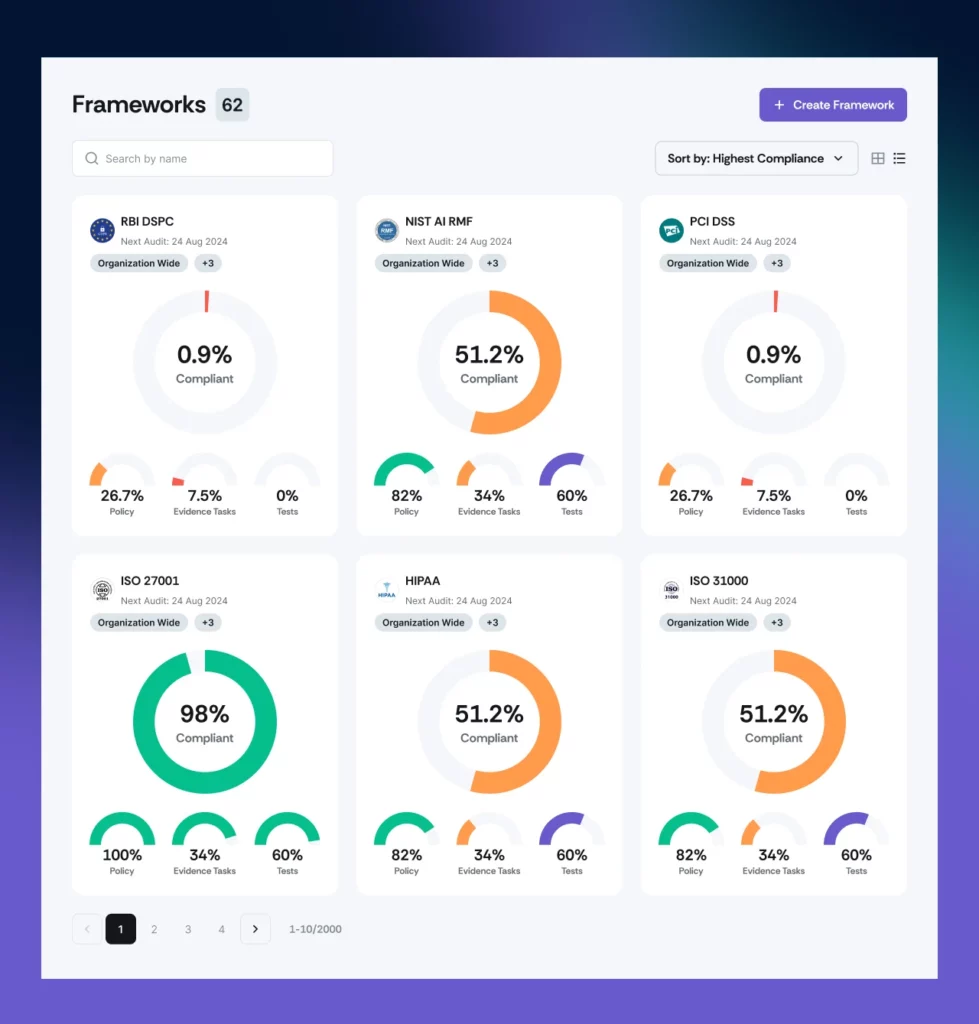
With Scrut, you can transition from a reactive, manual approach to an automated, proactive one—minimizing stress, reducing errors, and significantly shortening your ISO 27001 audit timeline.
Streamline compliance, automate evidence collection, and stay audit-ready effortlessly. Get started with Scrut today for faster, smarter ISO 27001 certification!
FAQs
Are all ISO standards audits the same?
No, ISO standards audits are not the same. Each audit focuses on the specific requirements of the standard, such as ISO 27001 for information security or ISO 9001 for quality management. While the core principles of auditing remain consistent, the objectives, criteria, and mandatory documents vary by standard.
What does an ISO 27001 report mainly consist of?
An ISO 27001 audit report primarily consists of an executive summary, the scope of the audit, audit objectives, and findings. It includes details on non-conformities, areas of improvement, and evidence supporting compliance. The report also outlines corrective actions required and recommendations to enhance the ISMS, providing a comprehensive overview of the organization’s alignment with ISO 27001 requirements.
What is the major difference between external and internal ISO 27001 audits?
The major difference between external and internal ISO 27001 audits lies in their purpose and who conducts them. Internal audits are conducted by the organization or a hired third party to assess ISMS effectiveness and prepare for external audits, while external audits are performed by accredited certification bodies to verify compliance and grant certification.
How often should ISO 27001 audits be done?
The frequency of ISO 27001 audits depends on the type of audit. Internal audits should be conducted at least annually to ensure the ISMS remains effective and compliant. External audits, including surveillance audits, are typically performed annually during the three-year certification cycle. Recertification audits are conducted every three years to renew the ISO 27001 certification. Regular audit frequency helps maintain compliance and address evolving security risks.
How long does it take to get ISO 27001 certified?
The time it takes to achieve ISO 27001 certification varies depending on the organization’s size, complexity, and readiness. On average, it can take 3 to 6 months for smaller organizations with a simpler ISMS, while larger organizations with complex operations may require 6 to 12 months or more.
The timeline includes preparing documentation, implementing controls, conducting internal audits, addressing non-conformities, and completing the external audit process. Efficient planning and tools like automation platforms can significantly reduce the time needed to get certified.
How to implement the ISO 27001 internal audit plan?
Implementing an ISO 27001 internal audit plan requires preparation to evaluate ISMS effectiveness and ensure compliance.
Steps to implement:
- Define scope: Identify processes and controls to audit.
- Prepare audit plan: Schedule tasks, timelines, and responsibilities.
- Gather documentation: Collect necessary ISMS records and evidence.
- Conduct audit: Evaluate processes, review evidence, and identify gaps.
- Document findings: Record non-conformities and improvement areas.
- Present results: Share findings with management for action planning.
- Implement corrections: Address gaps to strengthen the ISMS.
With proper preparation, the plan ensures effective audits and ISMS improvement.
How to create an ISO 27001 audit plan?
An ISO 27001 audit plan ensures internal audits are structured, effective, and compliant. Using an ISO 27001 checklist helps define scope, responsibilities, and methods.
- Define frequency: Plan audits annually or as needed based on risks.
- Set scope: Identify processes and controls to review.
- Assign responsibilities: Specify who plans, conducts, and reports.
- Choose methods: Use documentation reviews, interviews, and testing.
- Use checklist: Ensure all ISO 27001 clauses are covered.
- Schedule audits: Create a timeline for all audit phases.
- Get approval: Ensure management reviews and approves the plan.
A concise, approved audit plan supports compliance and continuous improvement.
What are the ISO 27001 certification audit stages?
This certification audit is conducted in two stages:
- Stage 1 (Documentation review): Evaluates ISMS documentation to ensure it aligns with ISO 27001 requirements.
- Stage 2 (Implementation audit): Assesses the implementation and effectiveness of controls and the overall ISMS.


















